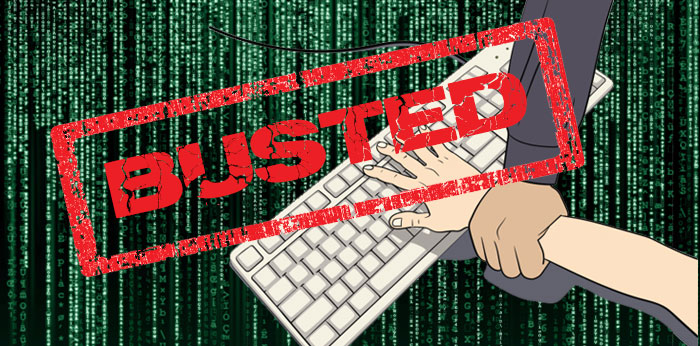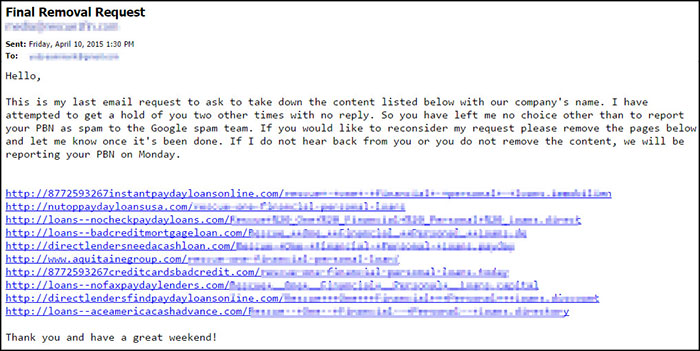
Over the last three years I have been monitoring a client’s online presence and reputation and I have seen over 300 spam results show up for their brand name. At first it started with free web 2.0 properties like WordPress.com, Weebly, etc., since then the results have evolved from squeeze pages to hacked WordPress websites.
However, unless you know about the spam there is no way of taking action. That is the reason I use branded alerts to alert me of any type of brand mentions online. Once the client’s brand name has been mentioned the results are delivered to my email inbox daily from tools like, Talk Walker Alerts, Google Alerts, and Mention. The other tool I recently started using is NUVI, this tool does not send me alerts but it allows me to search social media mentions as well as RSS feeds and other websites. By singing up for these tools you will have the ability to take action once the content has been indexed to prevent it from spreading like a wildfire.
Remove Web 2.0 Website Spam
Generating spam using Web 2.0 websites is fairly easy to do. One of the most common ways to generate large numbers of spam using these types of destinations, is by spinning an article as many times as you desire and paying a person from overseas that has the ability to generate a large number of profiles to which they will post the content to. A very popular destination to find these vendors is Fiverr and other crowd sourcing websites. On Fiverr you can buy up to 20 Web 2.0 profiles for $5.
This resource makes ability to publish spam online as easy as tying your shoes. Fiverr is not necessarily a bad destination nor am I suggesting that anyone steer clear of it, since there are thousands of legitimate resources to help you create images, videos, etc. But people are using it for the wrong reasons.
Removing the Web 2.0 spam is easy to do, just find the policy or report a problem page and report the issue to the support team and it will get removed within a few days.
Remove Squeeze/Landing Page Spam
Of the three types of spam content that I have had to deal with, this is the hardest to remove. The majority of the time these websites are owned by someone from overseas who was paid to post spam content. How do I know? Because they have mentioned it on their email reply. Here is why this is so time consuming; when they register their domains they pay for a private registration. Therefore if do not know of alternative ways to find a contact email, you can only email the registrars and they are not helpful.
Although it is harder to find the website owner, it is not impossible. Below are a few ways I use to find these people, since they seem to leave an online footprint most of the time. Plus most of the time they own some type of PBN where they publish the spam on.
Manual Search
This research approach at times has provided me with the results I needed without using any other tool. However, there are times when I have not been able to find a trace of the website owner’s contact information.
- “domain.com or website name””email or webmaster”
- “domain.com or website name””email or contact email”
Tools
Using these tools is a fairly easy way to find the website owner’s contact information as long as they have not purchased a private registration for their domain or domains.
- Netcomber.com
- Who.is
- Archive.org – Wayback Machine
Hybrid Approach
Most of these spammers are not as clever as they would like to think they are, although they used a private registration they used their real first and last name. Therefore once I find their name on who.is or Net Comber, here is the search I use to find their online profiles and contact info.
- “first and last name””domain name” – and I get their info from their LinkedIn profile, Twitter account or other related websites.
The outreach approach I use to get them to remove the spam content is, start with an email but if they ignore my email requests to remove the content. Then I will call them out on Twitter using their handle and also send them a message using LinkedIn. So what do I do if they still ignore me? Well, I send them one last email to let them know if they do not comply with my requests I am going to report their entire PBN to Google as spam and if I do not hear back from them; I do it.

Remove Hacked Websites Spam
This type of spam has been popping up on my radar more frequently. Spammers are looking for WordPress websites with outdated plugins, cracks in the code, no security, as well as other weaknesses. Spammers hack the website and add a page of spam from either the CPanel or the CMS without the owner knowing about it until I alert them. In the majority of the cases I either get a thank you for letting them know about the problem or they will inform that the website was hacked.
For this type of research it is very easy to do as well. Once I land on the page with the spam, I remove everything after the root domain and use their website to navigate my way to their contact page or an email account listed on the website. There have been cases in which the website owners are pretty upset and think that I hacked their websites to charge them money to fix it. After I educate them that if that is what they suspect all they have to do is contact their hosting company or Webmaster to identify where the hack came from based on the IP. Soon after that they take the spam content down.
Monitoring brand mentions and online reputations is not an easy feat but it is not impossible either as long as you know how to find spammers and stay on your toes at all times. Also think a little outside the box and using creativity goes a long way. If you are still reading this post and have would like to share your experience about removing spam or know of any other tactics or tools, I love to learn about tactics, experiences or tools I missed.




